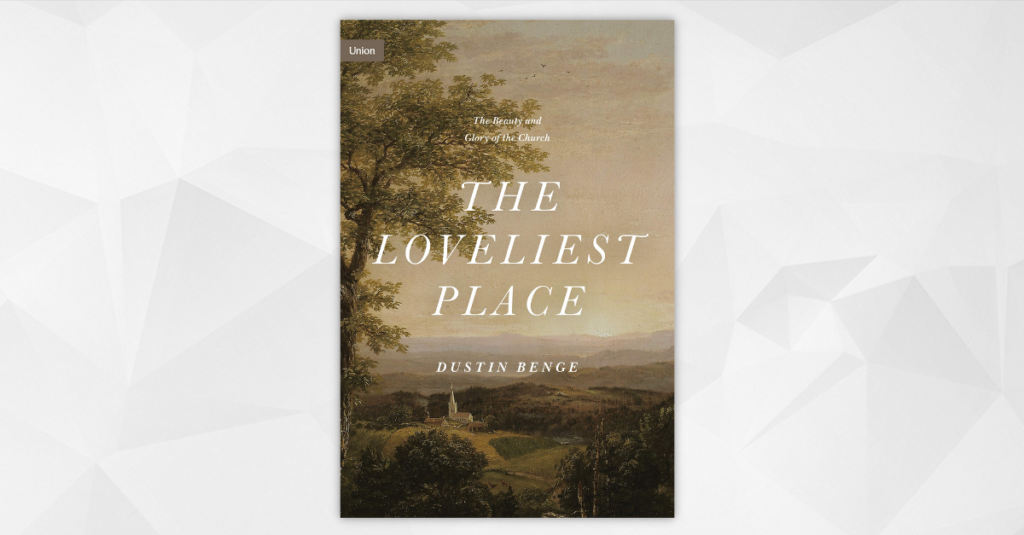Book Review: The Loveliest Place, by Dustin Benge
August 18, 2022

August 18, 2022
Dustin Benge, The Loveliest Place: The Beauty and Glory of the Church. Crossway, 2022. 208 pages.
Dustin Benge wrote The Loveliest Place “to awaken your affections . . . for who [the church] is and why she exists” (14).
Benge invites his readers to look up and beyond the grimy realities of everyday local church ministry, in order to gaze upon the refracted beauty of Christ’s radiant bride. His message countenances no grumbling discontent with the weaknesses of one’s local church, be it her ministry or her members. Rather, it gently cranes one’s neck heavenward to behold the wonders of how our triune God continues to purify his chosen bride, in order to display his glory in and through her. It gently shakes the reader awake to realities we know are resident in the church but sometimes struggle to behold in the dank, earthy trenches of Christian service.
“God has chosen to display his perfect beauty in his beloved bride by giving her to Christ as a majestic reward for his suffering,” Benge says. “As a result, the church is the brilliant reflection of God’s beauty and loveliness through Christ to the world” (28).
Benge summarizes the content of the book as “a thoroughly biblical portrait of the church that derives its life from the sweet fellowship of the Father, Son, and Spirit, creating a community of love, worship, fellowship, and mission, all animated by the gospel and empowered by the word of God” (16). In fourteen chapters, he teases out various aspects of this portrait.
The Loveliest Place leans more indicative than imperative. This is not to say the book lacks application, only that application never derails the book’s laser focus on exalted glories. Benge strives to stir up affections for the church as an exquisitely beautiful treasure, trusting that ontology (what the church is) will fuel warm zeal for economy (what the church does).
Benge threads through the warp and woof of his book well-chosen biblical prooftexts, but also delectable quotations from an array of dead authors, especially erstwhile Puritans. The ghosts of Calvin, Luther, Perkins, Sibbes, Goodwin, Gurnall, Owen, Bunyan, Edwards, Spurgeon, and more stalk these pages and fill out some of their loveliest places.
While no weakness of the book itself, there are a few places where The Loveliest Place may prove off-putting to some male readers who may be less than secure in their manhood—the title being one of those places. Readers of this sort may even require help hurdling the first chapter. Entitled “You are Beautiful,” this chapter tracks with the classic Puritan interpretation of Song of Solomon as a revelation of the love between Christ and his church. Some blokes may need a little help identifying as the ravishingly beautiful bride in the relationship. But it’s worth the effort to help them work through any such reticence.
Delving a little deeper, the reader will want to consider whether Song of Solomon intends to point to the love of Christ for his church. Do breasts, lips, and eyes describe body parts that enrapture the groom and point ultimately to the mystery of Christ’s love for his church? Or do breasts, lips, and eyes reveal figurative features that Christ sees in the church? Even if the reader does not adopt John Gill’s interpretive approach to the Song (18), Benge’s first chapter should hinder no one.
Pastors will also want to exercise caution with Benge’s references to Greek. For instance, he draws theological conclusions from etymological studies of the English word “church” (pp. 31-32). While the Greek origins of “church” which he cites may interest the reader, the lineage of an English word does not provide a valid source of theological conclusions. We must reserve such conclusions for the Greek word ekklesia. As another example, while Benge’s interpretation of “spirit” in John 4:24 is likely right, one should not similarly interpret all anarthrous uses of pneuma in the New Testament (90). Awareness of such matters will help forestall missteps in teaching.
This volume will edify many. In fact, it’s difficult to conceive of a faithful, adult church member who would not find it helpful. The Loveliest Place would stir up a body of elders by way of reminder. While perhaps the teacher would need to add meat to the bones, I suspect the book could serve as curriculum for an adult course or small group study. One could even use it fruitfully in the discipleship of a new believer.
If a believer’s reading capacity or ability to sustain interest is marginal, a companion volume that’s less than half the length ably summarizes the book; it’s called Why Should We Love the Local Church? This abridged volume may be read in one sitting, or one could spend a few minutes reading a chapter a day. While this slimmer volume is well written in its own right, its chief benefit is to entice one to read the unabridged volume.
The profundity of The Loveliest Place is not found in its novelties or a distinct angle on a familiar topic; instead, the book is profound because of its clear grasp of biblical realities. This book provides a straight-forward, clear-headed, devotionally-oriented portrait of what the church is and the glorious work of redemption God is bringing to completion in and through his beloved bride.
From new believers coming to wide-eyed terms with these realities, to battle-weary saints fixated on the muckiness of local church dynamics, to all manner of brothers and sisters living between these poles, this volume will refresh the soul. I finished it with misty eyes and a heart filled with thanksgiving that God has chosen to include his people in such wonders.